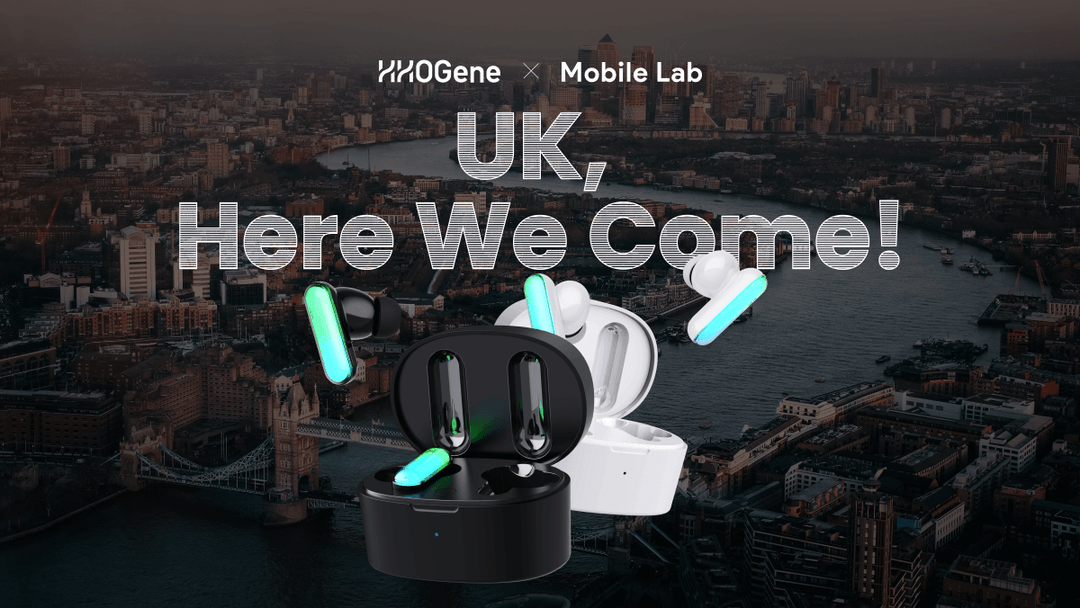What is ANC & How it works?
Noise-canceling earbuds are a very common ear protector and have a wide range of applications in people's daily life and production. Noise-canceling earbuds are composed of two hemispherical shells connected by an arch-shaped head ring, with sound-absorbing materials and sealing gaskets attached to the shell, and are suitable for environments where noise pollution exists.
According to the noise reduction mode, noise reduction earbuds can be divided into passive noise reduction earbuds (passive noise reduction earbuds) and active noise reduction earbuds (active noise reduction earbuds).
i. Passive noise cancellation earbuds (passive noise cancellation earbuds)
Traditional noise cancellation earbuds are generally passive noise cancellation earbuds, also known as passive noise cancellation earbuds; is the use of sound insulation principle to reduce noise personal protection devices, with the advantages of easy to wear, low price and so on. Passive noise-canceling earbuds have good noise reduction performance in the high frequency band, but the noise reduction performance in the low frequency band below 500 Hz is poor due to the volume and weight limitations of the earbuds.
ii. Active noise cancellation earbuds(active noise cancellation earbuds)
Earbuds containing active noise cancellation system, generally known as active noise cancellation earbuds, also known as active noise cancellation earbuds. Active noise cancellation system has good low-frequency noise reduction performance, which can achieve good noise reduction performance in a wider frequency band. HHOGene GPods is using this active noise cancellation technology for users's better noise reduction.
Noise is the sound emitted when a sound-emitting body makes irregular vibrations. Sound is produced by the vibration of an object and propagates in a particular medium (e.g. solid, liquid, gas) in the form of waves. From the physiological point of view, any interference with people's rest, study, and work and the sound to be heard produce interference with the sound, that is, unwanted sound, collectively referred to as noise. When the noise to people and the surrounding environment is caused by adverse effects, the formation of noise pollution. Since the industrial revolution, the creation and use of a variety of machinery and equipment have brought prosperity and progress to mankind, but at the same time has produced more and more powerful noise.
Generally speaking, three noise reduction measures are usually used to eliminate or reduce noise, namely noise reduction at the source, noise reduction during propagation, and noise reduction at the human ear; however, these methods are passive and often present disadvantages such as poor low-frequency noise reduction in the actual use process. In order to actively eliminate noise, people invented the technology of "active noise reduction", that is, active noise reduction technology.
 It can be assumed that all sounds consist of a certain spectrum and energy. Starting from the reception of noise sources, through electroacoustic processing, the calculation of the anti-phase wave, and through the built-in audio processing circuit for amplification and replay, the mutual anti-phase sound will be superimposed, and the amplitude of the noise will be significantly attenuated, thus reducing the noise.
It can be assumed that all sounds consist of a certain spectrum and energy. Starting from the reception of noise sources, through electroacoustic processing, the calculation of the anti-phase wave, and through the built-in audio processing circuit for amplification and replay, the mutual anti-phase sound will be superimposed, and the amplitude of the noise will be significantly attenuated, thus reducing the noise.
In one sentence summarize the principle of active noise reduction: by emitting the opposite phase of the noise, the frequency and amplitude of the same sound waves, and noise interference to achieve phase cancelation.
Active noise cancellation earbuds can be classified into analog and digital according to the control circuit, and into feed-forward, feedback and composite according to the control structure.
i. Feed-forward active noise cancellation earbuds
Feed-forward active noise cancellation earbuds use a feed-forward active noise control system, which is also called an open-loop noise control system, and its typical structure is shown below. This system generally requires the sound information of the primary sound field being controlled, which is usually called the reference signal. The reference signal is sent to the feedforward controller, and after processing by the controller, a corresponding control signal is generated to drive the loudspeaker to output the sound signal to produce the secondary sound field, which is then superimposed with the original acoustic signal actually coming through the physical path. The controller adjusts the intensity of the secondary source signal according to a specific algorithm.
 The advantage of feed-forward active noise control is that the outside microphone receives pure noise and does not receive the sound from the speaker, so the system is an open-loop and does not cause any closed-loop oscillations and whistling, so the circuit can be independently debugged to achieve the best effect of noise reduction. But the noise through the speaker and reflected in the speaker many times, its size and phase have changed, the noise collected by the outside microphone and the noise inside the speaker will be very different, and the direction of the external noise is very strong, it is difficult to use the same circuit to meet the noise reduction requirements from different directions, these are the problems that need to be overcome in the design of feed-forward active noise reduction earbuds.
The advantage of feed-forward active noise control is that the outside microphone receives pure noise and does not receive the sound from the speaker, so the system is an open-loop and does not cause any closed-loop oscillations and whistling, so the circuit can be independently debugged to achieve the best effect of noise reduction. But the noise through the speaker and reflected in the speaker many times, its size and phase have changed, the noise collected by the outside microphone and the noise inside the speaker will be very different, and the direction of the external noise is very strong, it is difficult to use the same circuit to meet the noise reduction requirements from different directions, these are the problems that need to be overcome in the design of feed-forward active noise reduction earbuds.
For HHOGene GPods, because we leave the most space for the light control chip and the light board, we do not have enough space for more mic, so our current first generation GPods are using feed-forward active noise cancellation technology.
ii. Feedback Active Noise Cancelling Earbuds
Feedback active noise cancellation earbuds use a feedback active noise control system, also known as a closed-loop noise control system, which has one less reference microphone than a feed-forward system, and its typical structure is shown below. Although the system composition is simplified, the application range is also greatly reduced.
 The signal from the secondary source will be determined by both the reference microphone and the error microphone. A feed-forward system attenuates the noise associated with the primary noise detected by the reference microphone, while a feedback system is very effective for narrowband noise.
The signal from the secondary source will be determined by both the reference microphone and the error microphone. A feed-forward system attenuates the noise associated with the primary noise detected by the reference microphone, while a feedback system is very effective for narrowband noise.
iii. Composite active noise cancellation earbuds
Composite active noise cancellation earbuds are used at the same time feed-forward active noise reduction system and feedback active noise reduction system, the combination of the two can enhance the flexibility of the active noise control system, so as to obtain a better noise reduction effect than the use of a single structure, but the disadvantage is that the system is complex to achieve, the cost is also relatively high.
 Active noise cancellation technology is an important means of noise cancellation, because many passive noise reduction means can not match the advantages, which also determines the bright future of this technology in the field of noise control. It is also believed that with the technical progress of the active noise cancellation core chip, the noise cancellation technology of TWS earbuds will have a stronger iteration in the future.
Active noise cancellation technology is an important means of noise cancellation, because many passive noise reduction means can not match the advantages, which also determines the bright future of this technology in the field of noise control. It is also believed that with the technical progress of the active noise cancellation core chip, the noise cancellation technology of TWS earbuds will have a stronger iteration in the future.
reference: https://www.jabra.com/blog/anc-headsets-arent-all-the-same-three-types-of-anc/
Find out more at www.hhogene.com/blog
According to the noise reduction mode, noise reduction earbuds can be divided into passive noise reduction earbuds (passive noise reduction earbuds) and active noise reduction earbuds (active noise reduction earbuds).
i. Passive noise cancellation earbuds (passive noise cancellation earbuds)
Traditional noise cancellation earbuds are generally passive noise cancellation earbuds, also known as passive noise cancellation earbuds; is the use of sound insulation principle to reduce noise personal protection devices, with the advantages of easy to wear, low price and so on. Passive noise-canceling earbuds have good noise reduction performance in the high frequency band, but the noise reduction performance in the low frequency band below 500 Hz is poor due to the volume and weight limitations of the earbuds.
ii. Active noise cancellation earbuds(active noise cancellation earbuds)
Earbuds containing active noise cancellation system, generally known as active noise cancellation earbuds, also known as active noise cancellation earbuds. Active noise cancellation system has good low-frequency noise reduction performance, which can achieve good noise reduction performance in a wider frequency band. HHOGene GPods is using this active noise cancellation technology for users's better noise reduction.
Noise is the sound emitted when a sound-emitting body makes irregular vibrations. Sound is produced by the vibration of an object and propagates in a particular medium (e.g. solid, liquid, gas) in the form of waves. From the physiological point of view, any interference with people's rest, study, and work and the sound to be heard produce interference with the sound, that is, unwanted sound, collectively referred to as noise. When the noise to people and the surrounding environment is caused by adverse effects, the formation of noise pollution. Since the industrial revolution, the creation and use of a variety of machinery and equipment have brought prosperity and progress to mankind, but at the same time has produced more and more powerful noise.
Generally speaking, three noise reduction measures are usually used to eliminate or reduce noise, namely noise reduction at the source, noise reduction during propagation, and noise reduction at the human ear; however, these methods are passive and often present disadvantages such as poor low-frequency noise reduction in the actual use process. In order to actively eliminate noise, people invented the technology of "active noise reduction", that is, active noise reduction technology.
 It can be assumed that all sounds consist of a certain spectrum and energy. Starting from the reception of noise sources, through electroacoustic processing, the calculation of the anti-phase wave, and through the built-in audio processing circuit for amplification and replay, the mutual anti-phase sound will be superimposed, and the amplitude of the noise will be significantly attenuated, thus reducing the noise.
It can be assumed that all sounds consist of a certain spectrum and energy. Starting from the reception of noise sources, through electroacoustic processing, the calculation of the anti-phase wave, and through the built-in audio processing circuit for amplification and replay, the mutual anti-phase sound will be superimposed, and the amplitude of the noise will be significantly attenuated, thus reducing the noise.In one sentence summarize the principle of active noise reduction: by emitting the opposite phase of the noise, the frequency and amplitude of the same sound waves, and noise interference to achieve phase cancelation.
Active noise cancellation earbuds can be classified into analog and digital according to the control circuit, and into feed-forward, feedback and composite according to the control structure.
i. Feed-forward active noise cancellation earbuds
Feed-forward active noise cancellation earbuds use a feed-forward active noise control system, which is also called an open-loop noise control system, and its typical structure is shown below. This system generally requires the sound information of the primary sound field being controlled, which is usually called the reference signal. The reference signal is sent to the feedforward controller, and after processing by the controller, a corresponding control signal is generated to drive the loudspeaker to output the sound signal to produce the secondary sound field, which is then superimposed with the original acoustic signal actually coming through the physical path. The controller adjusts the intensity of the secondary source signal according to a specific algorithm.
 The advantage of feed-forward active noise control is that the outside microphone receives pure noise and does not receive the sound from the speaker, so the system is an open-loop and does not cause any closed-loop oscillations and whistling, so the circuit can be independently debugged to achieve the best effect of noise reduction. But the noise through the speaker and reflected in the speaker many times, its size and phase have changed, the noise collected by the outside microphone and the noise inside the speaker will be very different, and the direction of the external noise is very strong, it is difficult to use the same circuit to meet the noise reduction requirements from different directions, these are the problems that need to be overcome in the design of feed-forward active noise reduction earbuds.
The advantage of feed-forward active noise control is that the outside microphone receives pure noise and does not receive the sound from the speaker, so the system is an open-loop and does not cause any closed-loop oscillations and whistling, so the circuit can be independently debugged to achieve the best effect of noise reduction. But the noise through the speaker and reflected in the speaker many times, its size and phase have changed, the noise collected by the outside microphone and the noise inside the speaker will be very different, and the direction of the external noise is very strong, it is difficult to use the same circuit to meet the noise reduction requirements from different directions, these are the problems that need to be overcome in the design of feed-forward active noise reduction earbuds.For HHOGene GPods, because we leave the most space for the light control chip and the light board, we do not have enough space for more mic, so our current first generation GPods are using feed-forward active noise cancellation technology.
ii. Feedback Active Noise Cancelling Earbuds
Feedback active noise cancellation earbuds use a feedback active noise control system, also known as a closed-loop noise control system, which has one less reference microphone than a feed-forward system, and its typical structure is shown below. Although the system composition is simplified, the application range is also greatly reduced.
 The signal from the secondary source will be determined by both the reference microphone and the error microphone. A feed-forward system attenuates the noise associated with the primary noise detected by the reference microphone, while a feedback system is very effective for narrowband noise.
The signal from the secondary source will be determined by both the reference microphone and the error microphone. A feed-forward system attenuates the noise associated with the primary noise detected by the reference microphone, while a feedback system is very effective for narrowband noise.iii. Composite active noise cancellation earbuds
Composite active noise cancellation earbuds are used at the same time feed-forward active noise reduction system and feedback active noise reduction system, the combination of the two can enhance the flexibility of the active noise control system, so as to obtain a better noise reduction effect than the use of a single structure, but the disadvantage is that the system is complex to achieve, the cost is also relatively high.
 Active noise cancellation technology is an important means of noise cancellation, because many passive noise reduction means can not match the advantages, which also determines the bright future of this technology in the field of noise control. It is also believed that with the technical progress of the active noise cancellation core chip, the noise cancellation technology of TWS earbuds will have a stronger iteration in the future.
Active noise cancellation technology is an important means of noise cancellation, because many passive noise reduction means can not match the advantages, which also determines the bright future of this technology in the field of noise control. It is also believed that with the technical progress of the active noise cancellation core chip, the noise cancellation technology of TWS earbuds will have a stronger iteration in the future.reference: https://www.jabra.com/blog/anc-headsets-arent-all-the-same-three-types-of-anc/
Find out more at www.hhogene.com/blog










Leave a comment